Understanding the Nde Feed Wagon: Innovations in Agriculture
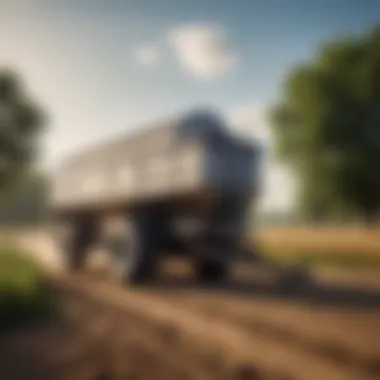
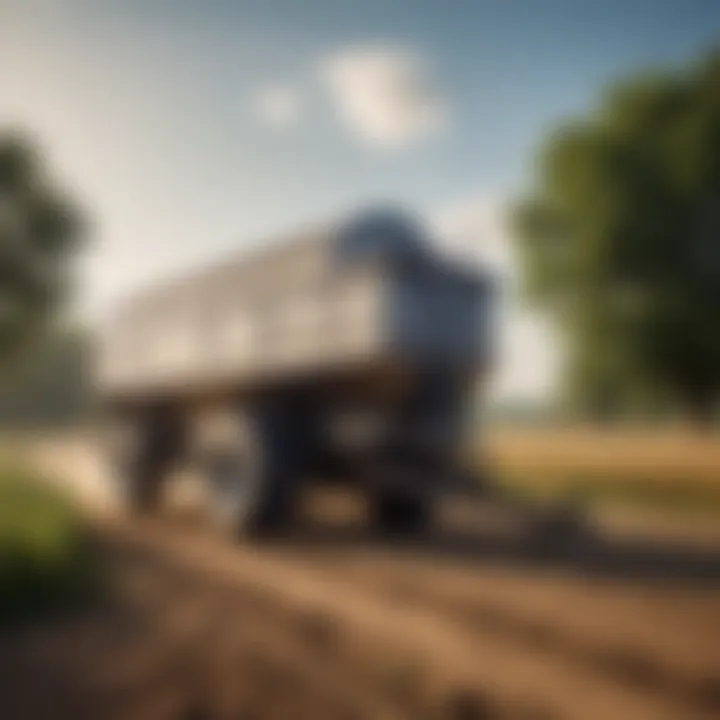
Intro
The Nde feed wagon represents a significant leap forward in modern agricultural practices. As the demands of livestock management evolve, so too must the tools that farmers use to ensure efficiency and productivity. The Nde feed wagon is tailored to meet these challenges, offering both innovation and practicality. In the following sections, we will explore its design, functionality, and many applications in agriculture today.
Key Concepts and Terminology
Understanding the Nde feed wagon starts with familiarizing oneself with key concepts and terminology that define its functionality and role in agriculture.
Basic Definitions
A feed wagon is a specialized piece of equipment designed to transport and distribute feed to livestock. The Nde feed wagon specifically emphasizes improved design features that enhance its user-friendliness and efficiency. Common terms associated with this equipment include:
- Feed Delivery: The process of moving feed from storage to livestock enclosures.
- Distribution Mechanism: Technology used within the feed wagon to ensure even spreading of feed.
- Capacity: Refers to the volume of feed that the wagon can hold.
Historical Context
Historically, feed wagons have evolved from simple wooden carts to complex machines equipped with advanced technology. The development of the Nde feed wagon illustrates how innovation can address the complexities of modern livestock farming. Notably, its introduction aligns with a broader trend of mechanization in agriculture aimed at increasing efficiency and reducing labor costs.
Recent Innovations and Trends
The Nde feed wagon showcases numerous recent innovations and trends that reflect contemporary priorities in farming. Understanding these developments is essential for farmers and enthusiasts alike.
Technological Advancements
The integration of technology has been pivotal in enhancing the performance of feed wagons. Key advancements include:
- GPS Tracking: Facilitates precise navigation and efficiency in feed distribution.
- Automation Features: Allows for remote operation, reducing the need for manual labor.
- Data Monitoring Systems: These systems gather real-time data on feed usage and livestock behavior, contributing to improved herd management.
Sustainable Practices
Sustainability is increasingly crucial in agriculture. The Nde feed wagon supports sustainable practices by:
- Reducing feed waste through accurate distribution.
- Enhancing resource management by minimizing the environmental impact of feed transportation.
Practical Applications and Techniques
To fully utilize the benefits of the Nde feed wagon, farmers should be aware of practical applications and techniques.
Step-by-step Guides
Implementing the Nde feed wagon in daily operations can follow these simple steps:
- Preparation: Make sure that the feed wagon is clean and in proper working condition.
- Loading Feed: Use the designed loading mechanism to fill the wagon with the necessary feed.
- Setting Parameters: Adjust the distribution settings based on livestock needs.
- Feeding Process: Navigate to the feeding area and engage the distribution mechanism for even spreading.
Case Studies
Examining successful implementations of the Nde feed wagon can provide valuable insights:
"Farmers who integrated the Nde feed wagon into their operations reported a 15% increase in feed efficiency and a noticeable improvement in livestock health."
Prolusion to the Nde Feed Wagon
The Nde feed wagon is more than just a tool in modern agriculture; it serves as a pivotal element in enhancing livestock management, feeding practices, and overall farm efficiency. Understanding its features and applications helps in recognizing how such equipment transforms agricultural operations today. This article dissects the various components of the Nde feed wagon, shedding light on its significance in livestock management and sustainable agricultural practices. It also introduces innovations that align with current technological trends, laying groundwork for future developments.
Historical Context
The design of feed wagons has evolved over many decades. Initially, livestock feeders relied mostly on manual processes, which could be labor-intensive and inefficient. Early models of feed wagons were simple structures pulled by horses or oxen. Over time, with the advent of modern machinery and vehicle technology, the concept changed drastically. The Nde feed wagon represents a culmination of this progression, often featuring advanced design elements, improved functionality, and durable construction, making it a preferred choice in contemporary farming.
Different cultures have contributed to the evolution of feed wagon technology. In various regions, specific needs shaped the design and usage of feed wagons. The automation of feeding processes, which began to take hold in the late 20th century, marks a significant milestone in the historical development of feed wagons. This shift has made it possible for farms to operate more efficiently, leading to a more productive livestock management system.
Purpose of the Nde Feed Wagon
The main purpose of the Nde feed wagon is straightforward: it is designed to transport and distribute feed to livestock. This practical objective encompasses several key benefits:
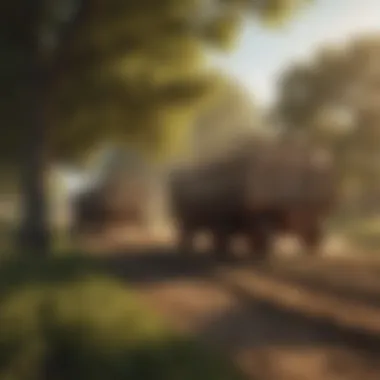
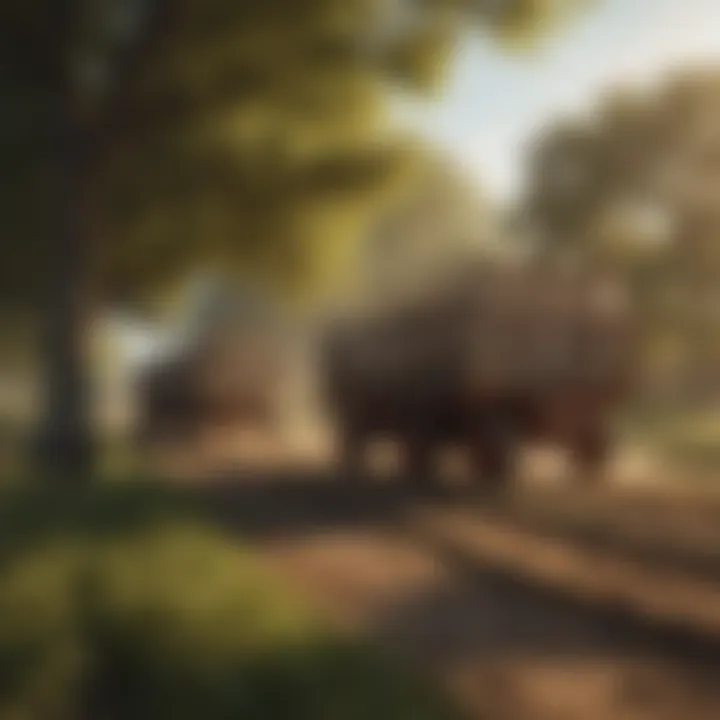
- Efficiency: The wagon simplifies the feeding process, allowing farmers to reduce time spent on feeding tasks.
- Consistency: The Nde feed wagon ensures a uniform distribution of feed. This leads to better nutrition for livestock, impacting growth and overall health.
- Versatility: It can manage various types of feed, from grains to silage, thus accommodating different feeding strategies.
- Labor Savings: By mechanizing the feeding process, farm operations can reduce manual labor costs, reallocating resources to other essential tasks.
In summary, the Nde feed wagon's integral role in modern agricultural practices cannot be overstated. It is not merely a transport tool; it is part of a larger strategy within farm operations aimed at improving productivity, efficiency, and sustainability.
Design and Engineering Principles
The design and engineering principles behind the Nde feed wagon play a crucial role in its efficiency and effectiveness in modern agriculture. Understanding these principles helps farmers and livestock managers appreciate the strategic thinking that goes into developing such equipment. Innovations in design not only improve operational efficiency but also enhance the longevity of the truck, ultimately contributing to better livestock management.
Materials Used
The choice of materials in constructing the Nde feed wagon has significant implications for its performance and durability. High-quality steel is often utilized due to its ability to withstand the rigors of agricultural environments. Corrosion-resistant coatings are also applied to protect the metal from harsh weather conditions and other environmental factors. Additionally, lightweight yet sturdy polymers may be used for non-load-bearing components to reduce overall weight without compromising strength.
Using the right combination of materials ensures that the feed wagon can handle heavy loads while remaining functional over time. The durability of materials helps minimize the need for repairs and replacements, which can be expensive and time-consuming. Furthermore, sustainable materials are increasingly incorporated to align with eco-friendly practices in agriculture.
Structural Features
The structural features of the Nde feed wagon are meticulously designed to cater to various operational requirements. Features like adjustable feed chutes, hydraulic lift systems, and reinforced frames contribute to its versatility. The adjustable feed chutes allow farmers to distribute feed uniformly, which promotes even intake among livestock. On the other hand, hydraulic systems facilitate easier loading and unloading processes, enhancing workflow on the farm.
The overall design must balance sturdiness with agility, allowing the feed wagon to navigate uneven terrain found in agricultural settings. Additional features, such as the incorporation of safety guards and ergonomic handles, improve the user experience and operational safety. These structural components must work in harmony, ensuring not only performance in feeding but also user friendliness.
Capacity and Size Considerations
Capacity and size are fundamental considerations when choosing an Nde feed wagon. The size of the wagon must correspond with the scale of the farming operation. A larger capacity wagon is ideal for extensive livestock farms, as it reduces the number of trips needed to feed animals, thus saving time and labor costs. Conversely, smaller operations may benefit from compact models that allow for maneuverability in confined spaces.
In deciding on size, considerations like weight distribution and compatibility with existing machinery also come into play. Ensuring that the feed wagon fits well with the farm’s equipment promotes operational synergy. Farmers should evaluate their specific needs and consult with manufacturers to determine the optimal size and capacity for their unique operations.
Understanding the design and engineering principles of feed wagons can lead to more informed decisions, ultimately benefiting productivity and efficiency on farms.
Functionality of the Nde Feed Wagon
The functionality of the Nde feed wagon is central to its role in modern agriculture and livestock management. This section aims to elucidate the various aspects that contribute to its operational success and efficiency. Understanding these functions provides insight on how the Nde feed wagon can improve productivity and optimize feed distribution, which is vital to maintaining healthy livestock. Key benefits include enhanced control over feed usage, reduced labor costs, and the ability to cater to the specific nutritional needs of different animals.
Operational Workflow
The operational workflow of the Nde feed wagon is designed to maximize efficiency and ease of use. It typically begins at the feed storage area, where different types of feed are stored. Farmers fill the feed wagon according to the dietary requirements of their livestock. The wagon is then used to distribute feed in an organized manner. This process can be summarized in several key steps:
- Loading the Feed: Users must carefully select and load the right type of feed into the wagon, taking into account the needs of the livestock.
- Transporting the Feed: The wagon is then driven to designated feeding areas. This transportation process is efficient because it minimizes the time spent moving from one location to another.
- Distributing the Feed: Once at the destination, the feed is dispensed evenly, allowing all animals equal access. This ensures that every animal receives the proper nutrition without overcrowding at feeding stations.
- Monitoring Usage: Many modern feed wagons come equipped with technology that allows farmers to monitor feed consumption closely. This data is crucial in managing both feed costs and animal health effectively.
Efficient workflow not only saves time but also helps farmers manage their resources better than traditional feeding methods. Using the Nde feed wagon can significantly reduce the amount of human labor needed, enabling farmers to focus on other aspects of their operation.
Types of Feed Managed
Another important function of the Nde feed wagon is its versatility in managing various types of feed. The wagon can handle different forms of feed, which is essential for meeting the nutritional demands of livestock. The primary types include:
- Pelleted Feed: The Nde feed wagon can easily transport pelleted feed, which is compact and ensures efficient nutrient delivery.
- Grain Mixes: This wagon can handle grain mixes that are tailored for specific livestock. Different mixtures can be used, depending on the growth stage or health of the animals.
- Forage: The wagon is also capable of distributing forage-based feeds, which are important for ruminants.
- Supplements: Additional nutritional supplements can also be fed through the Nde wagon, ensuring that animals receive all the vitamins and minerals they need for optimal health.
Effective feed management is crucial for maintaining livestock health, which directly impacts the productivity of a farm.
Technological Innovations in Feed Wagons
In the realm of modern agriculture, technological innovations in feed wagons signify a crucial advancement. These innovations not only improve the efficiency of feed distribution but also reshape how livestock is managed.
Automation and Control Systems
Automation in feed wagons refers to the use of smart technology to enhance everyday operations. This includes automated feed delivery, which minimizes human labor and ensures more consistent feeding schedules. Feed wagons equipped with automation can adjust feed amounts based on the specific dietary needs of each animal. Automated systems utilize sensors and scales to monitor feed levels and provide precise measurements needed to optimize livestock nutrition. This technology results in better herd health and increased productivity.
In addition, advanced control systems allow operators to monitor and manage multiple feed wagons remotely. They can set feeding times without being physically present on the farm, enabling greater flexibility and efficiency. The integration of GPS technology allows for precise location tracking, ensuring the feed is delivered exactly where it is needed.
Other benefits of automated systems include reduced feed waste and improved labor efficiency. By delivering the right amount of feed at the right time, these systems help to prevent overfeeding and underfeeding. According to recent studies, farms implementingsuch automation report a significant decrease in feed costs, which directly impacts overall profitability.
Integration with Farm Management Software
The integration of feed wagons with farm management software represents another fundamental innovation. This integration facilitates data collection and analysis, enabling farmers to make informed decisions. Through software interfacing, farmers can track feed usage patterns, animal health indicators, and overall productivity metrics.


Farm management software streamlines processes by providing real-time insights into feeding operations. This includes alerts for low feed levels and recommendations for adjustments based on herd performance data. With this information, farmers can adapt their feeding strategies to maximize the wellbeing of their livestock.
Moreover, such integrations enhance traceability and compliance with agricultural regulations. Data gathered can demonstrate adherence to nutrition guidelines and feed safety standards, which is increasingly important in today's market.
Case Studies of Nde Feed Wagon Usage
Examining case studies of the Nde feed wagon usage provides substantial insights into its effectiveness and capabilities within real-world agricultural settings. By looking at various examples, stakeholders can understand how this equipment has enhanced operational efficiency, productivity, and overall livestock management. Such detailed analysis helps both current users and prospective buyers assess the viability of incorporating the Nde feed wagon into their farming practices.
Successful Implementations
Numerous farms have demonstrated the successful implementation of the Nde feed wagon, showcasing its adaptability to different farm environments. One notable example is Clover Valley Farms, which integrated the Nde feed wagon into their operations to manage feed distribution for their dairy cattle. They reported a 30% increase in feed efficiency after employing this equipment, highlighting how precise feed delivery can influence livestock health.
Another significant case is Green Pastures Agricultural Cooperative, where multiple farms collaborated to share an Nde feed wagon. This cooperative model allowed them to reduce operational costs while maximizing the benefits of advanced feed management. The implementation resulted in not just improved feed accuracy but also a noticeable decrease in feed wastage, ultimately translating to enhanced profitability for all member farms.
Furthermore, a pilot program conducted by the Agricultural Innovation and Research Center demonstrated the Nde feed wagon's effectiveness in mixed farming systems. This project provided rigorous data on how the wagon facilitated better nutrient management, fostering improved yields in crops grown alongside livestock.
Lessons Learned
The experiences from various implementations of the Nde feed wagon have yielded valuable lessons that can inform future usage. One primary takeaway is the significance of tailor-made training for farm personnel. Proper education on the wagon's features and maintenance can prevent operational hiccups and ensure the equipment's longevity.
Additionally, managing expectations regarding financial investment is crucial. While the Nde feed wagon offers numerous advantages, upfront costs can be substantial. Farms should conduct thorough financial analysis to project the return on investment accurately, helping them to justify expenditures.
Stakeholders also learned the value of integrating feedback loops from end-users. Engaging farm workers in discussions about their experiences can unveil practical insights. For instance, adjustments to feed mix proportions made based on livestock health data led to improved weight gain in cattle, demonstrating how responsive management practices can optimize overall outcomes.
Economic Implications
The economic implications of the Nde feed wagon are critical for understanding its value in modern agriculture. As farms grow and the demand for efficient livestock management increases, it becomes necessary to analyze both the initial costs and the long-term benefits associated with such equipment. By doing so, farmers can make informed decisions that align with their financial objectives while enhancing productivity on their farms.
Cost of Acquisition and Maintenance
When considering the Nde feed wagon, the initial investment is often a primary concern for farmers. The cost of acquisition includes not only the price of the feed wagon itself but also any associated shipping and installation fees. Additional expenses may arise from necessary accessories or modifications to meet specific farming needs.
Once purchased, maintenance costs play a significant role in the overall economic picture. Regular maintenance ensures the longevity and reliability of the feed wagon, thereby preserving its value over time. Costs may include:
- Routine servicing and inspections
- Replacement of worn parts
- Fuel consumption
- Repairs after operational issues
Farmers should anticipate these ongoing costs and incorporate them into their overall budgeting process. A well-maintained feed wagon can prevent more significant expenses later, ultimately yielding cost savings.
Return on Investment Analysis
Return on investment (ROI) in relation to the Nde feed wagon should also be meticulously evaluated. Farmers can measure ROI by comparing the benefits gained from using the wagon against the total costs incurred, including both acquisition and maintenance. Key factors to consider in this analysis include:
- Increased Efficiency: Automated feeding processes reduce labor hours, allowing farm workers to focus on additional tasks.
- Reduced Feed Waste: Properly managed feed dispensing minimizes waste, thereby improving overall profitability.
- Enhanced Livestock Health: A consistent and controlled feeding routine can lead to better animal growth rates and health.
An effective ROI analysis may indicate that the Nde feed wagon not only pays for itself over time but also delivers significant gains that enhance overall farm operations. This highlights the importance of investing in modern agricultural technology, which aligns with the trends of increasing productivity and sustainability in livestock management.
Sustainability Practices
Sustainability has become a critical focus in modern agriculture. The Nde feed wagon plays a significant role in facilitating sustainable practices. This section explores how it contributes to reducing environmental impacts while increasing efficiency in livestock management.
Reduction of Feed Waste
One of the main advantages of the Nde feed wagon is its effectiveness in minimizing feed waste. Livestock farmers often struggle with the loss of feed due to inefficient feeding methods. The Nde feed wagon is designed to deliver exact portions of feed, which can significantly lower waste levels. This precision feeding not only ensures that animals receive the right amount of nutrients but also reduces the costs associated with excess feed loss.
Here are some specific ways the Nde feed wagon achieves this:
- Accurate Measurements: The wagon provides precise measurements of feed, preventing overfeeding and the subsequent waste.
- Targeted Distribution: By using technology to distribute feed, farmers can ensure that all animals have access to the food simultaneously, minimizing spillage and leftovers.
- Monitoring Systems: Integrated monitoring systems allow farmers to track feed usage effectively. These systems provide insights into consumption patterns, enabling adjustments to feed distribution.
"Effective use of the Nde feed wagon results in reduced operating costs and enhanced economic performance for livestock operations."
Environmental Impact Considerations
The environmental impacts associated with livestock farming are significant. The Nde feed wagon addresses several of these concerns by promoting more sustainable practices. Here are key factors to consider:
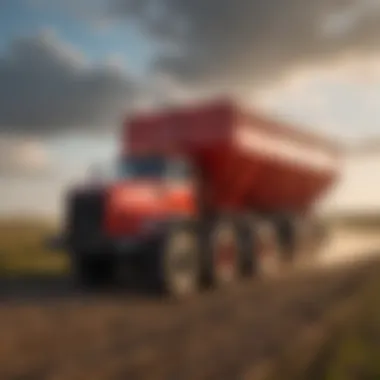

- Lower Carbon Footprint: By optimizing feed usage, the Nde feed wagon helps lower the overall carbon emissions associated with feed production and transportation.
- Resource Efficiency: Efficient feeding means that less feed is needed to maintain livestock health, conserving resources like water and land that would otherwise be used in production.
- Waste Reduction: Reduced feed waste translates to less manure production, thus decreasing the potential for harmful runoff into local waterways.
- Enhanced Biodiversity: Sustainable feed usage contributes to more balanced ecosystems, allowing for farmland that supports diverse species rather than monoculture systems.
Ultimately, the Nde feed wagon is not just a tool for feeding livestock; it is a cornerstone in the movement toward more sustainable agricultural practices, balancing the needs of farmers with the health of the environment.
Future Trends in Feed Wagon Technology
Understanding the future trends in feed wagon technology is crucial for farmers and livestock managers. It offers insights into how these innovations can improve farm operations, increase efficiency, and enhance productivity. As agriculture evolves, so do the tools used. Feed wagons must adapt to meet new demands. This section highlights emerging technologies and market growth predictions that will shape the future of feed wagons.
Emerging Technologies
Emerging technologies in the feed wagon industry are transforming how feed is distributed and managed. Some key innovations include:
- Smart Sensors: These devices monitor feed levels and quality, providing real-time data to operators. This allows for more accurate feed management, reducing waste and improving animal health.
- IoT Integration: Internet of Things (IoT) technology connects feed wagons to farm management systems. This integration enables remote monitoring and control, which can optimize feeding schedules based on livestock needs.
- Automation and Robotics: Automated feed wagons increase efficiency by performing repetitive tasks with minimal human intervention. Robotics can enhance precision in feed distribution, ensuring that animals receive the correct amount at the right time.
These innovations are not just conveniences; they address critical challenges in modern agriculture. By implementing these technologies, farmers can enhance productivity and reduce operational costs.
Predicted Market Growth
The market for feed wagons is expected to grow significantly in the coming years. Several factors contribute to this anticipated expansion:
- Rising Demand for Livestock Products: As global populations increase, so does the demand for meat and dairy products. This necessitates more efficient livestock feeding solutions.
- Advancements in Technology: Continued research and development in agricultural technology will lead to more sophisticated and efficient feed wagons. This will attract more farmers to adopt these innovations.
- Sustainability Practices: With an increasing focus on sustainable farming methods, feed wagons that minimize waste and maximize resource use are more appealing.
Industry experts predict a steady rise in the adoption of these advanced feed management systems, which will ultimately lead to enhanced productivity and profitability for farmers.
"Technological advancements in feed wagons are not just improving efficiency but also ensuring better care for livestock, which is vital for the sustainability of farming in the future."
Investing in feed wagon technology will not only align with market trends but also contribute to a more sustainable agricultural practice.
Challenges Facing Feed Wagon Adoption
The adoption of feed wagons, such as the Nde feed wagon, is often hindered by specific challenges. These barriers can limit their effective integration into everyday agricultural practices. Understanding these challenges is crucial for stakeholders in both livestock management and technology implementation. There are key elements to consider such as technical barriers and market resistance. These factors can affect not just the adoption but also the overall efficiency of farm operations.
Technical Barriers
Technical barriers encompass a range of issues that can impede the effective adoption of feed wagons. Integration challenges with existing farm equipment can present significant hurdles. Many farms operate using a variety of tools and techniques, which may not easily synchronize with advanced feed wagons. Additionally, there can be complex software integrations required for full automation, which some farmers may feel overwhelmed by. The learning curve associated with utilizing these technologies can discourage initial attempts to implement them.
Another concern is the maintenance and repair of these advanced machines. Farmers may not have the necessary technical skills locally available. This can result in increased downtime if a problem arises, leading to disruptions in feed management. The reliance on outside technicians can also add to operational costs.
Moreover, cost considerations cannot be overlooked. Advanced feed wagons often come with a significant price tag. This initial investment might deter smaller farmers who cannot easily absorb the extra expense when budgets are already tight.
Market Resistance
Market resistance represents another major challenge to the wide adoption of feed wagons. This resistance can arise from both consumers and farmers themselves. For some, the hesitance stems from a lack of information about the benefits these modern machines bring. They may be unsure about the perceived benefits and whether they justify the associated costs.
Additionally, cultural factors play a role. In many agricultural communities, traditional methods have been used for generations. This can make some people skeptical of new technologies. There can also be a fear amongst farmers that adopting the Nde feed wagon will not yield substantial improvements in productivity or profitability.
On the consumer side, there can be concerns regarding the environmental impact of large-scale feed processes. While modern feed wagons often come with eco-friendly technology, the initial association with industrialization can lead to pushback from environmentally conscious consumers.
"Adoption of new technology often hinges on a mix of perceived utility and cultural acceptance. Addressing these factors is essential for successful integration of feed wagons in farming."
Overall, recognizing the challenges of technical barriers and market resistance is essential for effective adoption. By addressing these concerns, the potential benefits of the Nde feed wagon can be realized, enhancing agricultural practices and livestock management.
Finale
The conclusion serves as a critical wrap-up of the extensive exploration surrounding the Nde Feed Wagon. It highlights the significant elements discussed throughout the article, drawing together themes of innovation, technological integration, and sustainability in modern agriculture.
By recapitulating the key points, readers can better appreciate the multifaceted role of the Nde Feed Wagon in livestock management. It is not only a tool for efficient feed distribution but also a vehicle that embodies advancements in engineering and technology. The Nde Feed Wagon is designed to optimize the feeding process, reduce waste, and ensure that livestock receive their necessary nutrition in a timely manner. Every aspect, from its materials to its functionalities, contributes to an overarching goal of enhanced productivity and sustainability in agriculture.
The benefits of adopting the Nde Feed Wagon are extensive. It facilitates a streamlined workflow on farms, reduces labor costs, and helps in monitoring the health of livestock through data collection. Furthermore, as farmers face increasing pressures from economic and environmental factors, the Nde Feed Wagon positions itself as an essential tool, potentially leading to more responsible farming practices.
Recap of Key Points
- The Nde Feed Wagon represents a pivotal innovation in feed distribution, capable of managing various types of feed efficiently.
- Its design incorporates advanced materials and structural features that enhance durability and functionality.
- Automation and integration with farm management software provide real-time insights for better decision-making in livestock management.
- Sustainability is achieved through reduced feed wastage and careful environmental considerations, aligning with the goals of modern agriculture.
- Economic implications such as cost analysis and return on investment highlight the wagon's relevance in today’s market.
Final Thoughts on the Nde Feed Wagon's Role
The Nde Feed Wagon is more than just a farm implement; it symbolizes a shift in how we approach livestock feeding and management.
It integrates technology in a sector that is traditionally seen as manual and labor-intensive. This integration is not merely a trend but a necessity in an era where efficiency and sustainability are paramount.
As agriculture faces various challenges, including climate change and resource management, innovations like the Nde Feed Wagon will likely play a transformative role. As farmers seek methods to improve their practices, adopting such tools can lead to a more sustainable and profitable future in agriculture.















